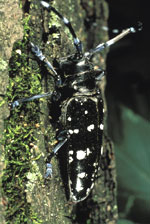Threats to Birds - Asian long-horned beetle (Anoplophora glabripennis)
Overview
The Asian long-horned beetle is a native of China and Korea, and was introduced to the U.S. accidentally in Chinese packing crates and shipments of bonsai plants. Infested trees were first discovered in New York in 1996 and in Chicago in 1998. Adult beetles have been intercepted at ports in 17 states. It has forced the destruction of thousands of trees in New York’s Central Park and in Chicago’s Lincoln Park. The larvae have a voracious appetite for wood. They are especially damaging to maples, horse chestnut, poplar, willow, elm, mulberry, and black locust. Females chew into the bark and lay eggs. The larvae hatch and chew their way further into the tree. After about a year the larvae become adult beetles and they chew their way out of the tree, leaving the tree riddled with holes and oozing sap. The U.S. Department of Agriculture believes this beetle has the potential to survive and reproduce in most parts of the U.S. where suitable host trees exist.
Description This large beetle is an inch long, shiny coal black with white spots. Its antennae are longer than the body with alternate black and white rings. The larvae look like big white worms. Females lay an average of 35 eggs during their 42 day life span. Birds Affected
If this beetle spreads to native forests it would impact resident and migratory forest birds.
Control
The beetles are resistant to pesticides. The only way to stop them is to uproot and burn the trees. |
